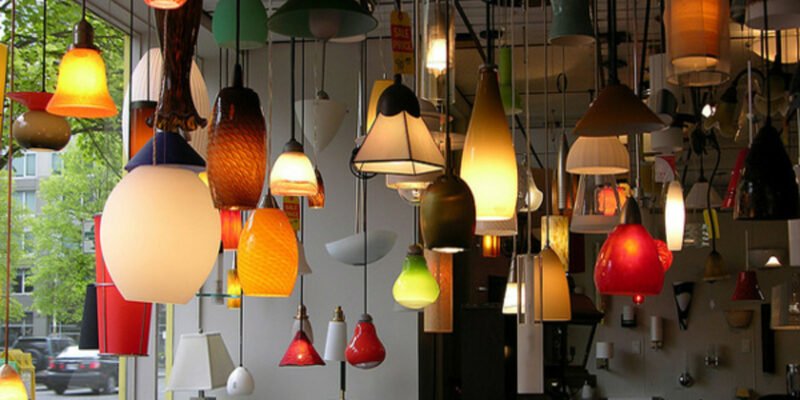Good home lighting is essential for any house. It can set the mood, make a space feel bigger or smaller, and highlight features you want to show off. With so many choices on the market, it can be tricky to know where to start. This guide will introduce you to the different styles of indoor lighting and how and where to use them in your home.
Styles of Lighting
Depending on the desired look and feel of a room, different styles of lighting may be used. For example, you’ll want a kitchen to be relatively bright so you can see your cooking, but you might want a dimmer living room to make it feel cozy.
The three most common styles of indoor lighting are ambient, task, and accent. Combining these three types of lighting makes it possible to create a variety of looks.
Ambient Lighting
Ambient lighting, also known as general lighting, is any type of lighting that evenly illuminates a room. The most common type of ambient lighting is overhead lighting from a ceiling fan or chandelier. Sometimes these fixtures can even be a stylish addition for luxury interior design. If you have a room with lots of natural light, that can also count as ambient lighting.
The purpose of ambient lighting is to provide a room with overall illumination so people can move around safely. It’s also the best lighting for carrying out tasks like cooking or reading. In bedrooms and living rooms, ambient lighting is often used with other types of lighting to create the desired effect.
Task Lighting
Task lighting is any type of light used to help you complete specific tasks like reading, cooking, or working at a desk. A task light should be bright enough to illuminate the entire work area to prevent eye strain.
The most common type of task lighting is a desk lamp. These lamps come in all shapes and sizes to fit any space. They also come in various styles, from sleek and modern to vintage-inspired designs. If you don’t have a lot of floor space in your home office, you might want to install wall sconces instead of a desk lamp. Just make sure they’re placed at the right height so they won’t cast shadows on your work surface.
Accent Lighting
Accent lighting highlights specific features in a room like artwork, architectural details, or plants. It’s usually much brighter than ambient or task lighting because its purpose is to draw the eye’s attention to a particular area.
LED strip lights or track lights are commonly used as accent lights since they add form and function to a space. Just be careful not to overdo it with accent lighting—too much brightness can be jarring and make a space feel cluttered.
Types of Lights
Many different types of lights can be used in a home, each with its advantages and disadvantages. Choosing between incandescent, LED, and fluorescent lighting depends on the look you’re going for, as well as the up-front cost, lifespan, and energy efficiency of the bulb.
Incandescent Lighting
Incandescent lighting is one of the most popular types of lighting for homes. It’s also one of the most affordable options. Incandescent bulbs produce light by heating a wire until it glows. However, incandescent bulbs are not very energy-efficient and they have a relatively short lifespan.
Incandescent lights are most commonly used in the home in table lamps, floor lamps, and other task lighting. They are often in some ceiling fixtures, particularly in the kitchen and bathroom. Plus, this type of light is warm and inviting, making it ideal for areas like living rooms and bedrooms. They’re also often used in decorations, such as string lights.
LED Lighting
LEDs, or light-emitting diodes, are small microchips that convert electricity into light. They are much more energy-efficient than incandescent bulbs and they have a much longer lifespan. LED bulbs are also available in a variety of colors, which gives you more flexibility when it comes to choosing the right type of light for your home. However, LED bulbs can be more expensive than incandescent bulbs upfront.
Common places to use LED lights in the home include under-cabinet lighting in the kitchen, recessed lighting in living rooms and bedrooms, and accent lighting to highlight paintings or architectural features.
Fluorescent Lighting
Fluorescent lighting is commonly used in kitchens and bathrooms because it provides bright, even light without generating a lot of heat. Fluorescent bulbs produce light by passing an electric current through a gas-filled tube. This type of light is more efficient than incandescent (though less than LED) and has a long lifespan, though at a cost.
In addition to serving as task lighting in kitchens and bathrooms, these lights are also often used in laundry rooms, basements, and garages, as they are bright enough to illuminate these typically dark spaces.
Light Up Your Home
Updating your home’s lighting can be a relatively easy and affordable way to improve your living space’s overall atmosphere, functionality, and aesthetics. By understanding the different types of indoor lights and their applications, you can make informed decisions about what will work best for your needs. With so many options available, there’s no excuse not to give your home a facelift with some new lights!













Comments